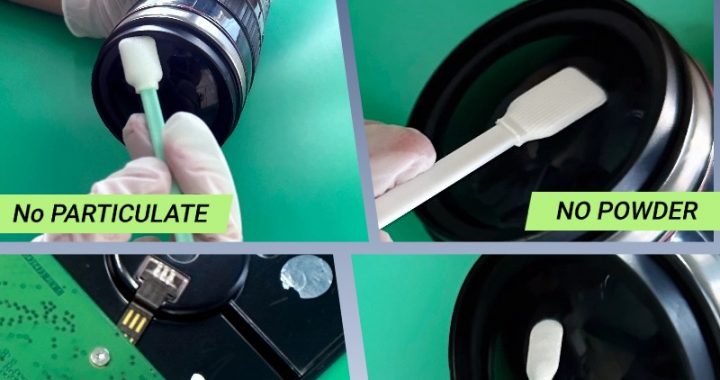In high-tech fields such as electronics manufacturing, precision instruments, and optical devices, selecting the right cleaning tool is crucial. Cleanroom swabs, with their unique features and performance, have become the preferred choice in these industries. So, what exactly are the characteristics of cleanroom swabs? Let’s take a closer look.
1. Introduction to Cleanroom Swabs
Cleanroom swabs, also known as anti-static swabs or static-free purification swabs, are specialized cleaning tools designed for use in dust-free environments. Made using high-tech materials and special processes, they offer excellent absorption, cleaning capabilities, and anti-static properties, effectively removing tiny particles, dust, and oils. Throughout production, packaging, and transportation, cleanroom swabs are handled in dust-free environments to ensure their cleanliness and safety.
2. The Three Major Types of Cleanroom Swabs
Based on the materials and applications, cleanroom swabs can be classified into three main categories:
1. Fabric Tip Cleanroom Anti-Static Swabs
Characteristics:
- Material: Made from ultra-fine microfiber fabric, usually using polyester or nylon materials, with excellent absorption capabilities.
- Softness: The fabric tip is soft and lint-free, preventing scratches or damage to the cleaned surface.
- Application: Suitable for cleaning precision electronic components, optical instruments, lenses, and displays. It’s particularly ideal for cleaning devices with high surface requirements.
Advantages: Fabric tip swabs can clean crevices and grooves effectively, absorbing oils and dust while offering high durability.
2. Sponge Tip Cleanroom Anti-Static Swabs
Characteristics:
- Material: Made from high-density polyurethane sponge, with a soft tip and excellent liquid absorption capability.
- Chemical Resistance: It is resistant to various solvents and chemicals, such as isopropanol (IPA) and acetone.
- Application: Ideal for cleaning print heads, optical lenses, magnetic heads, and other solvent-sensitive equipment.
Advantages: Sponge tip swabs have strong absorbency, provide effective cleaning, and produce minimal lint, making them ideal for absorbing liquids and contaminants.
3. Foam Tip Cleanroom Anti-Static Swabs
Characteristics:
- Material: Made from open-cell polyurethane foam with good liquid absorption and abrasion resistance.
- Anti-Static Performance: Foam tip swabs have excellent anti-static properties, effectively preventing static damage to electronic components.
- Application: Commonly used in industries such as semiconductors, PCB, LCD displays, and LEDs.
Advantages: Foam tip swabs not only provide significant anti-static performance but also have strong liquid absorption capabilities, ensuring thorough cleaning without damaging the equipment.
3. Main Features of Cleanroom Swabs
Cleanroom swabs are widely used across various industries due to the following characteristics:
- Excellent Anti-Static Performance: Made from anti-static materials, they effectively prevent static buildup, protecting sensitive electronic components.
- Strong Absorption: These swabs have high absorbency, quickly absorbing liquids, dust, and oils to ensure effective cleaning.
- Lint-Free: Strict control over dust pollution during production ensures the swabs don’t shed fibers or dust during use, making them suitable for high-cleanliness environments.
- Diverse Options: With fabric, sponge, or foam tip options, cleanroom swabs meet various cleaning requirements across different environments.
- Chemical Resistance: Cleanroom swabs are resistant to a variety of chemical solvents, making them suitable for use with cleaning agents like isopropanol and acetone.
4. Applications of Cleanroom Swabs
Cleanroom swabs are widely used in the following industries and fields:
- Electronics Manufacturing: For cleaning PCB boards, chips, semiconductors, and connectors, ensuring product quality.
- Optical Equipment: Cleaning camera lenses, microscopes, and optical instruments to maintain equipment performance.
- Medical Devices: Used in dust-free environments such as operating rooms and laboratories to clean medical instruments and equipment.
- Printing Equipment: For cleaning thermal print heads and inkjet print heads, extending equipment life.
- Precision Instruments: Suitable for cleaning and maintaining watches, jewelry, and precision machinery.
5. How to Choose the Right Cleanroom Swab
When selecting a cleanroom swab, consider factors such as the material of the cleaning object, surface requirements, and the usage environment. For example:
- For high-precision optical instruments, fabric tip cleanroom swabs are recommended.
- For solvent-sensitive equipment, sponge tip cleanroom swabs are more suitable.
- For cleaning electronic components that require anti-static protection, foam tip cleanroom swabs are the best choice.
This article provides a comprehensive analysis of the three main types of cleanroom swabs, their characteristics, applications, and guidance on selecting the right swab. Choosing the appropriate cleanroom swab can not only improve cleaning efficiency but also effectively extend the lifespan of equipment and ensure product quality. I hope this article is helpful to you!






